Tenzing–Hillary Airport
| Tenzing–Hillary Airport तेन्जिङ हिलारी विमानस्थल | |||||||||||
|---|---|---|---|---|---|---|---|---|---|---|---|
|
| |||||||||||
| Summary | |||||||||||
| Airport type | Public | ||||||||||
| Serves | Lukla, Nepal | ||||||||||
| Focus city for | |||||||||||
| Elevation AMSL | 9,334 ft / 2,845 m | ||||||||||
| Coordinates | 27°41′16″N 086°43′53″E / 27.68778°N 86.73139°ECoordinates: 27°41′16″N 086°43′53″E / 27.68778°N 86.73139°E | ||||||||||
| Map | |||||||||||
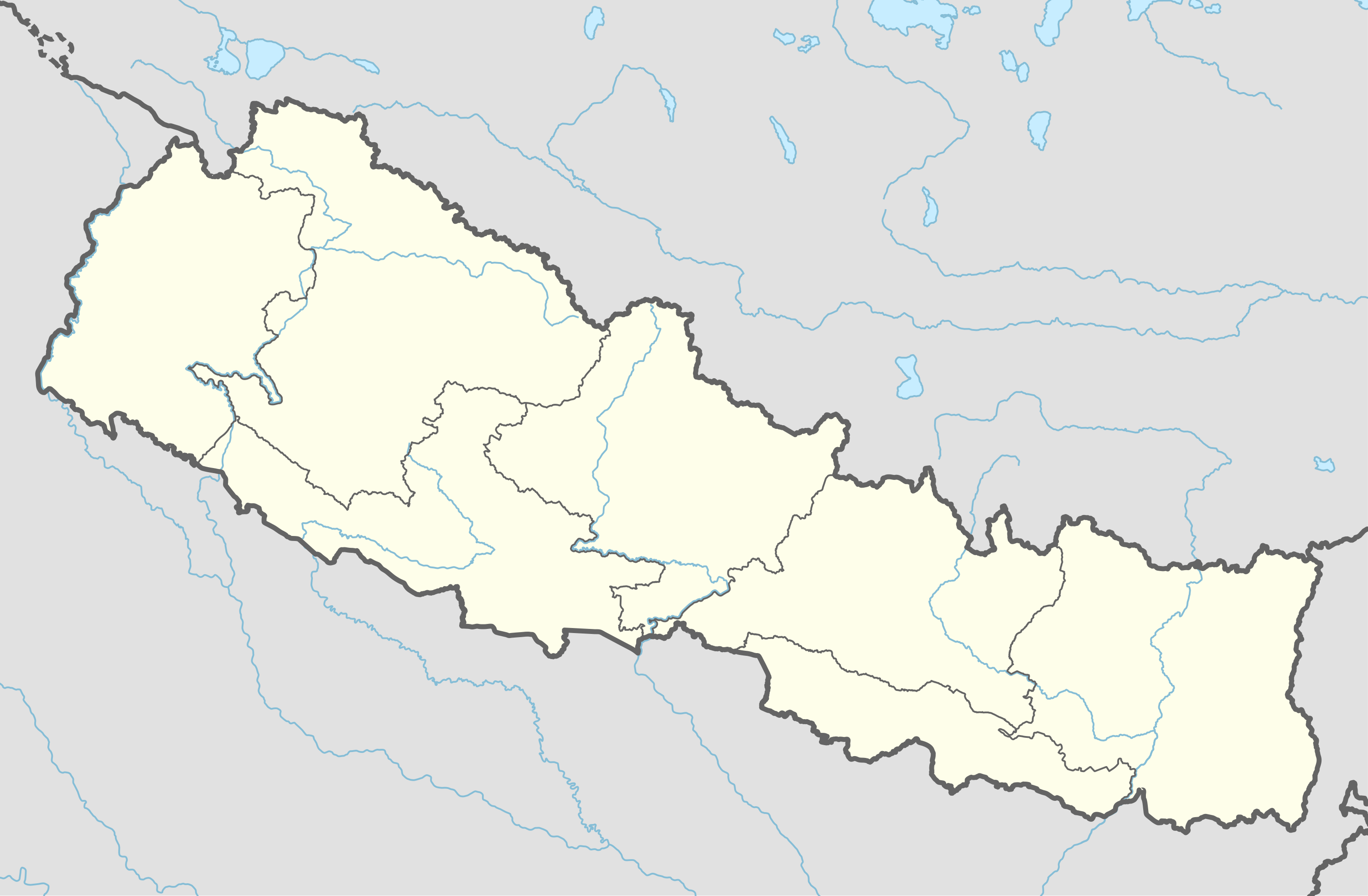 LUA Location of airport in Nepal | |||||||||||
| Runways | |||||||||||
| |||||||||||
Tenzing–Hillary Airport (IATA: LUA, ICAO: VNLK), also known as Lukla Airport, is a small airport in the town of Lukla,[2] in Khumbu, Solukhumbu District, Province No. 1, eastern Nepal. A program titled Most Extreme Airports, broadcast on The History Channel in 2010, rated the airport as the most dangerous airport in the world for over 20 years.[3]
The airport is popular because Lukla is the place where most people start the climb to Mount Everest Base Camp. There are daily flights between Lukla and Kathmandu during daylight hours in good weather. Although the flying distance is short, rain commonly occurs in Lukla while the sun is shining brightly in Kathmandu. High winds, cloud cover, and changing visibility often mean flights can be delayed or the airport closed. The airport is contained within a chain link fence and patrolled by the Nepali armed police or civil police around the clock.[3]
History
The airport was built in 1964 under supervision of Edmund Hillary, who originally intended to build the airport on flat farmlands. However, local farmers did not want to give up their land, so the airport was built at its current position. Hillary bought the land from local Sherpas for 2650 US-Dollar and involved them in building the facilities.[4] It has been said that Hillary was unhappy with the runway's soil resistance, and that his solution was to buy local liquor for the Sherpas and ask them to perform a foot-stomping dance to flatten the land which served as the runway.[5] The runway was not paved until 2001.[6]
In January 2008, the airport was renamed in honor of Sherpa Tenzing Norgay and Sir Edmund Hillary, the first people to reach the summit of Mount Everest and also to mark their efforts in the construction of this airport.[7]
Facilities
The airport's paved asphalt runway is accessible only to helicopters and small, fixed-wing, short-takeoff-and-landing aircraft such as the De Havilland Canada DHC-6 Twin Otter, Dornier Do 228, L-410 Turbolet and Pilatus PC-6 Turbo Porter. The runway is 527 m (1,729 ft) × 30 m (98 ft) with a 11.7% gradient.[1] The airport's elevation is 9,334 ft (2,845 m).[1] The airport is not only used for passenger flights, but also for transporting most of the building material and cargo to the town, as most of the roofs on the houses at Lukla have to be transported by aircraft.
The Tenzing–Hillary Airport is frequently referred to as the most dangerous airport in the world.[3] Arriving and departing aircraft must use a single runway. There is low prospect of a successful go-around on short final due to the terrain. There is high terrain immediately beyond the northern end of the runway and a steeply angled drop at the southern end of the runway into the valley below.[8]
Due to the difficulties of successfully landing at the airport, the Civil Aviation Authority of Nepal sets high standards, for which only experienced pilots, who completed at least 100 short-takeoff-and-landing (STOL) missions, have over one year of STOL experience in Nepal and completed ten missions into Lukla with a certified instructor pilot, are allowed to land at the airport.[9][10]
Airlines and destinations
| Airlines | Destinations |
|---|---|
| Nepal Airlines | Kathmandu[11] |
| Sita Air | Kathmandu[12] |
| Summit Air | Kathmandu[13] |
| Tara Air | Kathmandu[14] |
Statistics
Passenger numbers
| Passengers[15][16][17] | |
|---|---|
| 2003 | 70,959 |
| 2004 | |
| 2005 | |
| 2006 | |
| 2007 | |
| 2008 | |
| 2009 | |
| 2010 | |
| 2011 | |
| 2012 | |
| 2013 | |
| 2014 | |
| 2015 | |
| 2016 | |
Accidents and incidents
- On 15 October 1973, a Royal Nepal Airlines DHC-6 Twin Otter 300 (registration 9N-ABG) was damaged beyond repair on landing. The three crew and three passengers were unhurt.[18]
- On 9 June 1991, a Royal Nepal Airlines DHC-6 Twin Otter 300 (registration 9N-ABA) from Kathmandu crashed at the airport while attempting to land following an unstabilized approach in bad weather. The three crew and fourteen passengers escaped with injuries.[19]
- On 26 September 1992, a Royal Air Nepal Harbin Yunshuji Y-12-II (registered 9N-ACI) faltered during takeoff and was damaged beyond repair. All twelve passengers and two crew survived.[20]
- On 25 May 2004, while on approach to the airport, a Yeti Airlines DHC-6 Twin Otter 300 (registration 9N-AFD) from Kathmandu crashed into Lamjura Hill in heavy clouds. No passengers were on board; all three crew members were killed. The Nepalese accident investigation committee concluded that the captain provided inaccurate information about his position to the Area Control Centre.[21]
- On 1 October 2004, on landing at the airport, a Sita Air Dornier Do 228 suffered a collapse of its nose gear and slid along the runway, blocking it once it had come to rest. The airport was closed for two days.[22]
- On 30 June 2005, a Gorkha Airlines Dornier Do 228 skidded off the runway while attempting to land. The nine passengers and three crew suffered minor injuries. The aircraft was reportedly withdrawn from service and written off after the accident.[23][24]
- On 8 October 2008, Yeti Airlines Flight 103, a DHC-6 Twin Otter 300 (registration 9N-AFE) crashed on final approach and caught fire, killing eighteen passengers and crew. The aircraft's captain was the only survivor. Video of the incident showed inclement weather at the time of the incident.[25]
- On 12 October 2010, a Sita Air Dornier Do 228 (registration 9N-AHB) lost braking control and struck the wall-end of the runway during landing. All passengers and crew escaped injury; the aircraft's nose was damaged.[26]
- On 26 September 2013, an Air Dynasty helicopter (registration 9N-AEX) crashed when the rear rotor touched the barbed wire of the compound wall at the airport. All three passengers and the captain survived.[27]
- On May 27th 2017, Summit Air Flight 409 was performing a freight flight on a Let L-410 from Kathmandu to Lukla (Nepal) with three crew, was on final approach to Lukla's runway 06 at about 14:04L (08:19Z) with poor visibility when the aircraft touched a tree short of the runway and subsequently contacted ground about 3 meters/10 feet below the runway level. The aircraft slid down the slope before coming to a rest about 200 meters below the runway level. The captain was killed and the first officer, Shrijan Manandhar, died in hospital almost eight hours later. The third crew member received injuries and was evacuated to Kathmandu the following day after the weather had cleared.[28][29][30]
Gallery

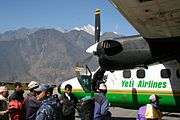
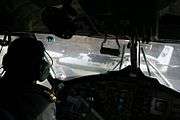
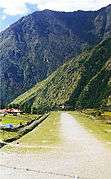
See also
References
- 1 2 3 "NATIONAL AIRPORTS PLAN Current Situation and Diagnostic" (PDF). Civil Aviation Authority of Nepal. Retrieved 7 March 2015.
- 1 2 Airport information for Lukla, Nepal – Tenzing–Hillary Airport (VNLK / LUA) at Great Circle Mapper.
- 1 2 3 "Most Extreme Airports". History Specials. Season 1. Episode 104. The History Channel. 26 August 2010.
- ↑ Ibišbegović, Denis; Vesić, Zoran; Dikić, Nenad (2012). Inspirisani trenutkom: put za Everest bazni kamp. Belgrade: Nenad Dikić. pp. 49–50. Retrieved 30 October 2017.
- ↑ "Nepal quake tough test for 'world's most dangerous airport'". The Himalayan Times. Retrieved 30 October 2017.
- ↑ "This Is the World's Most Dangerous Airport". CN Traveler. Retrieved 30 October 2017.
- ↑ "Nepal to name Everest airport after Edmund Hillary and Tenzing Norgay". International Herald Tribune. 15 January 2008. Archived from the original on 12 February 2008. Retrieved 27 April 2010.
- ↑ "Why Is Lukla Airport the Most Dangerous Airport in the World?". February 27, 2018.
- ↑ "Flight Operations Requirements Aeroplane (Appendix 9)" (PDF). Civil Aviation Authority of Nepal. Retrieved 30 October 2017.
- ↑ "Incident: Nepal Airlines DHC6 at Solukhumbu on Apr 19th 2010, hard landing". The Aviation Herald. Retrieved 30 October 2017.
- ↑ "Domestic Schedule". Nepal Airlines. Retrieved 1 October 2018.
- ↑ "Flight Schedule". Sita Air. Retrieved 1 May 2018.
- ↑ "Flight Schedule". Summit Air. Retrieved 1 October 2018.
- ↑ "Flight Schedule". Tara Air. Retrieved 1 October 2018.
- ↑ "Civil Aviation Report 2009-2010" (PDF). Civil Aviation Authority of Nepal. Retrieved 1 June 2018.
- ↑ "Civil Aviation Report 2011-2012" (PDF). Civil Aviation Authority of Nepal. Retrieved 1 June 2018.
- ↑ "Civil Aviation Report 2017" (PDF). Civil Aviation Authority of Nepal. Retrieved 1 June 2018.
- ↑ Aviation Safety Network. Retrieved 18 November 2006.
- ↑ "ASN Aircraft accident de Havilland Canada DHC-6 Twin Otter 300 9N-ABA Lukla Airport (LUA)". Retrieved 23 June 2011.
- ↑ "ASN Aircraft accident Harbin Yunshuji Y-12-II 9N-ACI Lukla Airport (LUA)". Aviation-safety.net. 26 September 1992. Retrieved 9 February 2012.
- ↑ Aviation Safety Network. Retrieved 18 November 2006.
- ↑ Aviation Safety Network. Retrieved 19 November 2006.
- ↑ Airline Industry Information, 30 June 2005.
- ↑ Aviation Safety Network. Retrieved 18 November 2006.
- ↑ BBC News. Retrieved 8 October 2008.
- ↑ Air Crash Observer "Archived copy". Archived from the original on 7 July 2011. Retrieved 7 July 2011. . Retrieved 15 December 2010
- ↑ "Chopper crashes in Lukla, minor injuries". Nepalnews.com. 26 September 2013. Archived from the original on 3 March 2016.
- ↑ "Accident: Summit L410 at Lukla on May 27th 2017, contacted trees and impacted ground before runway". The Aviation Herald. 27 May 2017. Retrieved 28 May 2017.
- ↑ "Lukla air crash toll reaches 2 as co-pilot dies for want of treatment". The Himalayan Times. 28 May 2017. Retrieved 30 May 2017.
- ↑ "Kiwi 'heroes' in dramatic Mt Everest rescue after cargo plane slams into mountain". New Zealand Herald. 29 May 2017. Retrieved 18 June 2017.
External links
| Wikimedia Commons has media related to Lukla Airport. |
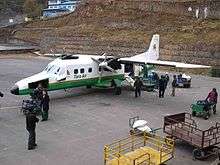
.jpg)